Like the concept of mercantilism, that of advertising – in the sense of messages conveyed for the purpose of encouraging recipients to undertake some commercial action – is one that has been associated with the post-medieval history of commerce, particularly with British imperialism. But as with many other features of commerce that became far more pronounced later, traces of advertising can be made out in the Late Middle Ages. When we consider that shops took the form of simply-structured booths or the front rooms of houses, with little to distinguish one from the other, and that traders in the same types of goods tended to group together in particular parts of streets, individual shopkeepers may have felt the need firstly to identify the presence of their businesses, and secondly to differentiate themselves in some way from their competitors.
Probably the earliest known form of identification in the Middle Ages was the use of signs hung out at front to identify a location as a place selling ale and/or wine. Foliage (notably ivy and grape vines) had been used in Roman times to identify wine taverns, as was a suspended shield or signboard, examples of which have been found at Pompeii. In the Middle Ages a building was identified as a tavern by affixing an ale-stake, a vertical or, more commonly, horizontal pole. In addition taverns and other breweries would hang out a piece of foliage to signify when a new batch of ale had been brewed on the premises, or received from a brewer elsewhere; this was for the benefit both of customers and of officials who had to check the quality of the brew. Whether this use of foliage was a survival of the Roman tradition or its reintroduction at later period is uncertain.
The generic ale-stake did not differentiate one such establishment from its competitors, so signs began to become more elaborate and variegated. In London at least, to differentiate taverns selling ale from those selling wine, the former began adopting the sign of a hoop hung from the pole, and the next step was to place different emblems within the hoop. Animals and everyday objects were often used, while elements from heraldic shields were also mimicked – perhaps inspired by such shields affixed outside townhouses of nobility, some of which, when not in use by the owners, might be used as hostelries for travellers. These visual emblems,and sometimes the hoop itself, gave names to the taverns, such as the Bell on the Hoop, Swan on the Hoop and Crane on the Hoop. An artist's rendering of the Lendit Fair shows a number of structures with such signs. This kind of mnemonic iconography was well-suited to an age in which literacy had not penetrated far into society.
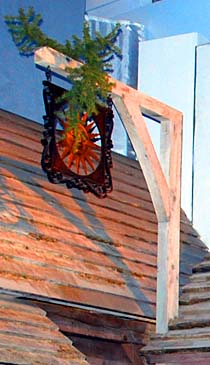
(above) Sign outside a reconstruction of an
eighteenth-century inn.
The image of the sun was perhaps homage to the Sun-King Louis XIV, while
the spruce bough attached to it signals that a fresh brew of spruce beer is available.
(below) The sign of the Red Lion Hotel,
Colchester, illustrates how modern inn and pub signs are developments from those of
the Middle Ages.
Photos © S. Alsford
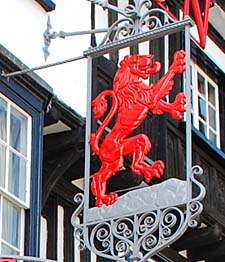
Possibly it was the example of taverns that encouraged shopkeepers to identify their businesses with hung signs, or perhaps it was simply a parallel rational development. Such signs aimed at communicating to passers-by the character of the goods or services available. Shop signs were fairly common in Roman cities such as Pompeii and generally incorporated some emblem connoting the service, a characteristic tool, or the type of goods provided by the establishment; such symbols became common elements in artistic depictions of trades as well as in the arms adopted by craft or mercantile gilds. these signs became a form of branding shops and their offerings, creating a commercial identity, but without the degree of individualization later found. In 1375 the London authorities prohibited alestakes, or any other pole bearing a shop sign, from extending more than seven feet out from a building, because of their impediment to riders using the street and the risk posed of them falling on pedestrians below.
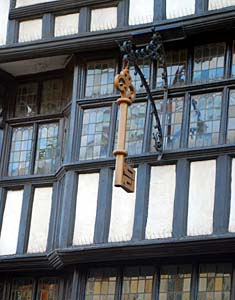
(above) The House of the Golden Key, Tewkesbury,
is a sixteenth-century building with an old trade sign in the form of a key
hung from a wrough-iron bracket, representing the ironmongers shop that occupied
the street-level frontage ca.1900.
(below) A nineteenth-century shop sign in the Strangers Hall museum, Norwich.
It takes the form of a gilded wooden sheep suspended from a black metal band;
traditionally the sign of a wool tapler, but probably used for the shop of
a clothier and hatter.
Photos © S. Alsford
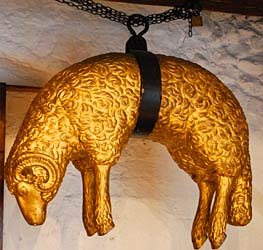
An atypical use of what could be interpreted as signage occurs at Dragon Hall, Norwich. Stone corbels at either end of the street-facing corners of the building were sculpted: one (now much weathered) apparently portraying a husband and wife in harmony and the other (close to the entrance into the trading hall) depicting the wife forcefully scolding or rebuking her spouse. Whether this was intended as a kind of marketing message, suggesting to townsmen that domestic harmony might be attained through gifts of Toppes' fine cloth, we can only speculate; but Toppes' trading establishment was ahead of its time in various ways, and it is hard to see why money would have been spent on such carvings otherwise. When Goldsmiths' Row was built in London (1491) its multi-storey frontage bore depictions of wild men of the woods, a symbol associated with the goldsmith's trade, but this was simply an identifying symbol, without the kind of marketing message we can infer from the Dragon Hall sculptures.
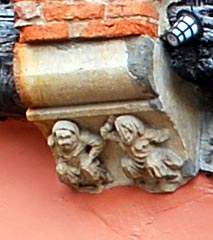
Photo © S. Alsford
(above) The Dragon Hall corbel showing the wife berating
her husband.
(below) This detail from an illustration in a French manuscript of ca.1480 could
be considered germane to the Dragon Hall sculpture. It shows a husband trying
to tear way from a mercer's shop his resisting wife who is looking at fineries there.
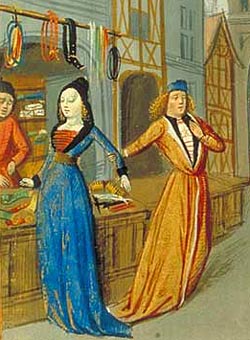
Bibliothèque nationale de France, Arsenal
A second method of advertising might be considered a viva voce technique. The town crier is a well-known minor medieval official, still in existence today in many places simply for reasons of tradition; his proclamation of new by-laws, annual reminders of existing legislation, and other civic announcements accustomed people to receiving information in that way. Such criers would also announce the deaths of prominent members of the community and exhort listeners to pray for the deceased; they may well have undertaken other private commissions outside their public duties. Although, again, this form of advertising was used in the Ancient World, it seems natural that medieval traders would adopt such a method to promote their wares or services without necessarily any direct inheritance from the past.
Crying wine was an established, indeed institutionalized, promotional technique in France as early as a royal charter of 1141 to the province of Berry, which recognized twelve official criers, of whom five might go about the taverns advertising the quality and price of wine and offering samples for people to taste. Although there is little evidence of such criers in England, Caxton's inclusion in his Dialogues – part translation, part adaptation of a Flemish work – of a wine crier in his catalogue of occupations suggests it was something that would not seem alien to his English readers. A Philip le Criour is heard of in London in 1299, and the by-name occasionally appears later, but the scope of activities of its holders is uncertain.
What little evidence we have,however, suggests public crying of commercial goods and services, a well-known feature of Early Modern London and Paris, may not have been uncommon in late medieval English shopping areas. In Piers Plowman Gluttony is solicited in the street by a brewster who extols her ale and persuades him to try some. At the close of the prologue, as Langland describes the cast of extras who inhabit his dream world, is another mention of taverners crying the wines they have in stock, as well as cooks and their servants crying their "hot pies, hot!" and urging passers-by to come and dine on roast geese; but Langland is not intending to arouse his audience's appetite, for he later condemns brewsters, baxters, butchers and cooks for doing harm to poor people by selling them low quality comestibles. Illustrations of taverns and inns suggest it may have been common practice for the keeper or his wife or employee to hover about the entranceway, on the lookout for prospective customers, and then try to to entice them in with either fair promises or samples of the fare. Certainly it seems to have been common in France, judging from literary references.
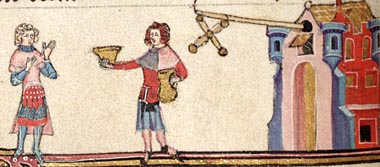
British Library
(above) An innkeeper, positioned by the road outside his door, tries to attract
a client with a sample of his wine.
(below) A female crier of dried herring, with money-bag at front of her apron,
depicted in the Cris de Paris, ca. 1500
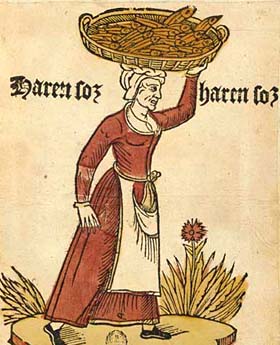
Bibliothèque nationale de France, Arsenal
It is the London Lickpenny that is our best source of evidence for the precursor of the famous cries of street-vendors of a later age. The central figure and narrator, a Kentish hick visiting London, first encounters, at Westminster, traders urging him to buy felt hats or reading glasses; then, as he passes out of Westminster into the city, cookshop owners beckon him into their establishments to dine on what they have to offer. As he advances into the city he encounters the cries of street sellers: "ripe strawberries", "cherries on the branch", "hot peas", while a shopkeeper signals to him to come over and look at the spices he has for sale. The pressure intensifies as he reaches Cheapside, London's main shopping district, and continues to Candlewick Street; here he is assailed by drapers urging him to buy their cloth or a cap to cover his head, and other traders pushing hot sheeps feet, fresh rushes, and fish, while another cook is crying his beef ribs and pies of various kinds. Reaching Cornhill, his sleeve is caught by a taverner who suggests he could do with a pint of wine and the Kentishman, probably wearied by the noisy sales pitches of so many others, succumbs and spends what appears his only penny.
If we consider the Lickpenny an accurate portrayal of a city's shopping streets, then it was not uncommon in the Late Middle Ages for traders to have touters for business positioned near the doors of their establishments, each vying to out-shout the others to capture the attention and interest of passers-by; such behaviour remained common in the urban marketplaces of England until the late twentieth century, when civic ordinances restricted it. The display of sample goods in shop windows was evidently considered insufficient, at least by keepers of shops in shopping streets, to attract custom, while pedlars almost inevitably had to cry their goods to gain attention.
Mention might also be made of the use of merchants' marks and makers' marks as an early form of branding; although not introduced for promotional purposes, they served to link merchandize, and public perceptions of quality, with particular businessmen or manufacturers. Such things, along with trade signs and sellers' cries, may represent simple beginnings; but, as the saying goes, every journey begins with one small step. In the closing decades of the Middle Ages, the invention of the printing press would provide a technology for future expansion of advertising initiatives. One of the first would be the production of advertising posters. Around 1480 one produced by Caxton advertised a printed collection of procedural rules for priests available for purchase from the Westminster almonry under the sign of the red pole; because such posters were not made for long-term retention, it is hard to know how widely they may have been used in the early decades of printing.